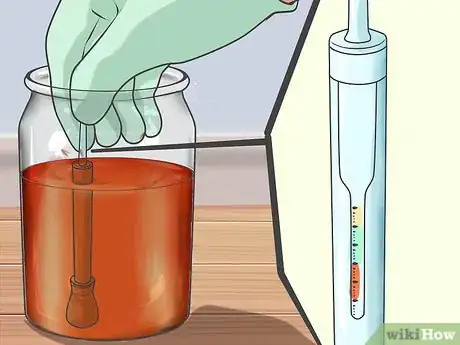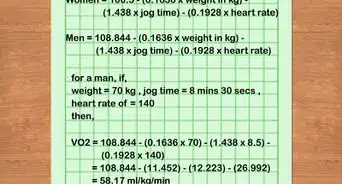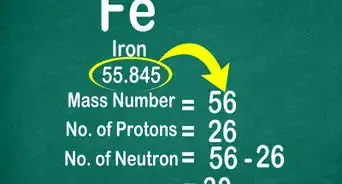This article was co-authored by Bess Ruff, MA. Bess Ruff is a Geography PhD student at Florida State University. She received her MA in Environmental Science and Management from the University of California, Santa Barbara in 2016. She has conducted survey work for marine spatial planning projects in the Caribbean and provided research support as a graduate fellow for the Sustainable Fisheries Group.
There are 10 references cited in this article, which can be found at the bottom of the page.
This article has been viewed 195,648 times.
A hydrometer is a measurement tool, usually made from a weighted glass tube, used to test the density of a liquid. The idea behind the hydrometer is that suspending a solid object in a liquid will cause the solid to float to the same degree as the weight of the displaced fluid. This means the tool will sink lower in a less dense liquid. Brewers use hydrometers to track the progress of beer or other fermented drinks, since the liquid's density decreases as yeast converts sugar into alcohol.
Steps
Taking a Reading
-
1Check your hydrometer's temperature calibration. Hydrometers measure the density of a liquid, but liquids expand and contract with temperature changes. To get an accurate answer, you need to test liquids at the temperature your hydrometer was designed for. This temperature should be listed on the hydrometer label, or on instructions in the same package.
- Most homebrew hydrometers are calibrated at 59–60°F (15–15.6°C ), and most laboratory hydrometers are calibrated at 68°F (20.0°C).
- Hydrometers can lose accuracy over time. If you're using an old tool, you may want to test it first.
-
2Measure the temperature of the liquid. If this is more than a degree or two off from the hydrometer's intended temperature, write down the result. Your measurement will be off, but you can correct it using the temperature chart at the end of this article.
- If testing homebrewed wort, do not contaminate it with a non-sanitized thermometer. Use an adhesive strip thermometer that sticks to the side of the container, or measure a sample instead of the main batch.
Advertisement -
3Pour a sample into a clean container. Choose a transparent jar or cup large enough that the hydrometer can float without hitting the sides or bottom of the container. Transfer a sample of the liquid into this container.
- When brewing, test the wort after visible signs of fermentation have ended, but before pitching the yeast. Transfer the sample using a sanitized siphon, wine thief, or baster.[1]
- If precision is extremely important, rinse the container with a small amount of the liquid before adding the full sample.
-
4Insert the hydrometer into the liquid. Make sure the hydrometer is dry, then lower it into the liquid just below the point at which it would float naturally. Be sure the hydrometer bulb does not touch the sides or bottom of the jar when it settles.
-
5Spin the hydrometer gently. This will dislodge air bubbles clinging to the tool, which would disrupt the measurement. Wait for the hydrometer and the liquid to stop moving, and for bubbles to dissipate.
-
6Read the hydrometer scale at the lowest point of the liquid's surface. The surface of the fluid may cling to the hydrometer and the container walls, forming a curve called a meniscus. Look for the scale mark on the hydrometer level with the lowest point on the fluid's surface. Do not use the mark where the fluid touches the hydrometer.[2]
-
7Understand the measurement. The most common scale on hydrometers is "specific gravity." This is the ratio of the liquid's density to the density of water. Pure water should give a reading of 1.000. A higher reading means the liquid is denser (heavier) than water, and a lower reading means it is lighter.
- The specific gravity of wort (called original gravity or OG by brewers) varies greatly. The more sugar in a wort, the higher the OG, and the higher alcohol content in the final beer. Most beers OGs fall in the 1.030 to 1.070 range, but they can be significantly higher.[3]
-
8Interpret the Plato, Balling, or Brix scales. Your hydrometer may use one of these scales instead, or you may need to convert your measurement to follow a certain recipe. Here's how to measure density using these three units:
- The Plato scale measures the percentage of sucrose in a wort, so 10 degrees on the Plato scale means 10% of the wort is sucrose by weight. Multiply the Plato measurement by 0.004 and add 1 for a specific gravity estimate that's close enough for homebrewing purposes. For example, a 10 degrees Plato wort has a specific gravity of 10 x .004 + 1 = 1.040. (The further you get from this number, the less accurate the conversion is.[4] )
- The Balling and Brix scales measure the sugar concentration in a solution, but the units are close enough to the Plato scale that you can use them interchangeably for home brewing. Commercial breweries use more exact conversion formulas, and conduct their own tests to calibrate the Brix scale based on various factors.[5]
-
9Take a reading of the final brew. At the end of the entire brewing process, test additional samples daily with the hydrometer. If the reading is the same two days in a row, no more sugars are being converted into alcohol, meaning fermentation is complete. The final reading at this point is the "final gravity" or "FG." The target FG depends on what kind of brew you are making, and in some cases on additional ingredients that affect the hydrometer reading.
- With a few exceptions, most beers have an FG around 1.007 to 1.015.[6]
- Home brewers rarely get the exact FG predicted by their recipe, especially on their first few attempts. It's more important that the beer tastes good, but keep records and keep studying the process to get a more consistent result.
-
10Estimate alcohol by volume. The difference between the original gravity and final gravity tells you how much sugar was converted to alcohol. The formula 132.715 x (OG - FG) is a useful way to convert this into alcohol by volume (ABV). Note that this is only an estimate, and is most accurate for beers with a final gravity around 1.010.[7]
- For example, if your OG was 1.041 and your FG is 1.011, the ABV is roughly 132.715 x (1.041 - 1.011) = 3.98%.
Testing Your Hydrometer
-
1Fill a container with water. To test whether the hydrometer is accurate, use distilled water or reverse osmosis water. If you use tap water or untreated bottled water in your brewing, you can test with that instead. The mineral content will alter the results, but this will tell you how to adjust your readings for brews made with that specific water.
-
2Bring the water to the correct temperature. The hydrometer's calibrated temperature should be marked on the hydrometer label or the package instructions.
-
3Measure the density of the water. Place the hydrometer in the water, spin gently to shake off air bubbles, and wait for it to settle. The hydrometer will read 1.000 for pure water if it is perfectly calibrated.
- A hydrometer that uses the Plato or Balling scale will read 0.00º.
- See the instructions above for a more detailed guide on how to use the hydrometer.
-
4Write down the correction if the hydrometer is inaccurate. If you get a result other than 1.000, the hydrometer is off (or your water contains minerals). Write down the amount you need to add or subtract to future readings to correct this error.[8]
- For example, if your hydrometer reads 0.999 in pure water, add 0.001 to all measurements.
- To take another example, if your hydrometer reads 1.003 in tap water, subtract 0.003 from all measurements of liquid brewed with that specific tap water. Test the hydrometer again if you change water sources.
-
5Consider replacing or adjusting your hydrometer. If your hydrometer is significantly off, it's often best to order a new one. The old one may lose even more accuracy over time, but it is possible for the frugal brewer to correct it:[9]
- If the measurement is too low, attach tape, nail polish, or any other material to increase the weight until the measurement is correct.
- If the measurement is too high, file the edge to remove material. Seal the rough area with nail polish to protect against glass dust or sharp edges.
Community Q&A
-
QuestionWhat are the units of a hydrometer reading?
 Community AnswerThe most common scale, specific gravity, does not have units. It compares the density of the liquid to the density of water, so the result is in the form of a ratio or percentage. For example, a result of 1.050 means the liquid is 1.050 times as dense as water.
Community AnswerThe most common scale, specific gravity, does not have units. It compares the density of the liquid to the density of water, so the result is in the form of a ratio or percentage. For example, a result of 1.050 means the liquid is 1.050 times as dense as water. -
QuestionHow do you find the percentage of sugar from the specific gravity reading?
 Community AnswerA hydrometer with the Plato scale gives you the result directly: one degree Plato = 1% of sucrose by weight. To convert (roughly) from specific gravity to Plato, subtract 1, then divide by 0.004.
Community AnswerA hydrometer with the Plato scale gives you the result directly: one degree Plato = 1% of sucrose by weight. To convert (roughly) from specific gravity to Plato, subtract 1, then divide by 0.004. -
QuestionCan I use a hydrometer to test the salt content of water?
 Community AnswerYes. You aren't testing the salt content per se, you're testing the density of the water compared to ideal, pure water. However, for all intents and purposes, if you're testing seawater, then you're testing the salinity by testing the density. Note that the density of water also changes with temperature (and to a lesser and irrelevant for your purposes degree, pressure). There are formulas to adjust your measurement based on temperature.
Community AnswerYes. You aren't testing the salt content per se, you're testing the density of the water compared to ideal, pure water. However, for all intents and purposes, if you're testing seawater, then you're testing the salinity by testing the density. Note that the density of water also changes with temperature (and to a lesser and irrelevant for your purposes degree, pressure). There are formulas to adjust your measurement based on temperature.
Temperature Adjustment
- Adjust temperature for a standard hydrometer. If your hydrometer is calibrated for 60ºF (15.6ºC), use the following chart when measuring at different temperatures. Find the temperature of the liquid in column 1 or 2, then add the number from the same row of column 3 to the specific gravity:[10]
Warnings
- Never return a wort or beer sample back to the fermentation container after testing, or you could contaminate the batch. Taste it to see how the beer is coming along, then throw it away.⧼thumbs_response⧽
References
- ↑ https://grainfather.com/forced-fermentation-test-what-is-it-and-why-do-it/
- ↑ https://www.homebrewersassociation.org/how-to-brew/how-to-take-an-accurate-hydrometer-reading/
- ↑ https://www.homebrewersassociation.org/how-to-brew/how-to-take-an-accurate-hydrometer-reading/
- ↑ http://byo.com/stories/item/411-calibrate-your-hydrometer-and-fermenter-techniques
- ↑ http://byo.com/hops/item/1313-refractometers
- ↑ http://www.brewersfriend.com/2009/02/04/beer-styles-original-gravity-and-final-gravity-chart/
- ↑ http://learn.kegerator.com/specific-gravity/
- ↑ https://byo.com/mead/item/411-calibrate-your-hydrometer-and-fermenter-techniques
- ↑ https://www.homebrewersassociation.org/how-to-brew/how-to-take-an-accurate-hydrometer-reading/
About This Article
To read a hydrometer, pour a sample of the liquid you want to test into a clean, transparent container. Lower the hydrometer into the liquid and stir it around gently, but make sure it doesn’t touch the sides of the container. Read the hydrometer scale at the lowest point of the surface of the liquid. The most common scale on hydrometers is specific gravity, in which pure water measures 1.000. If you get a higher reading, your liquid is heavier than water, and if you get a lower reading, it’s lighter. Keep reading for tips from our reviewer on how to read Plato, Balling, or Brix scales.













































































